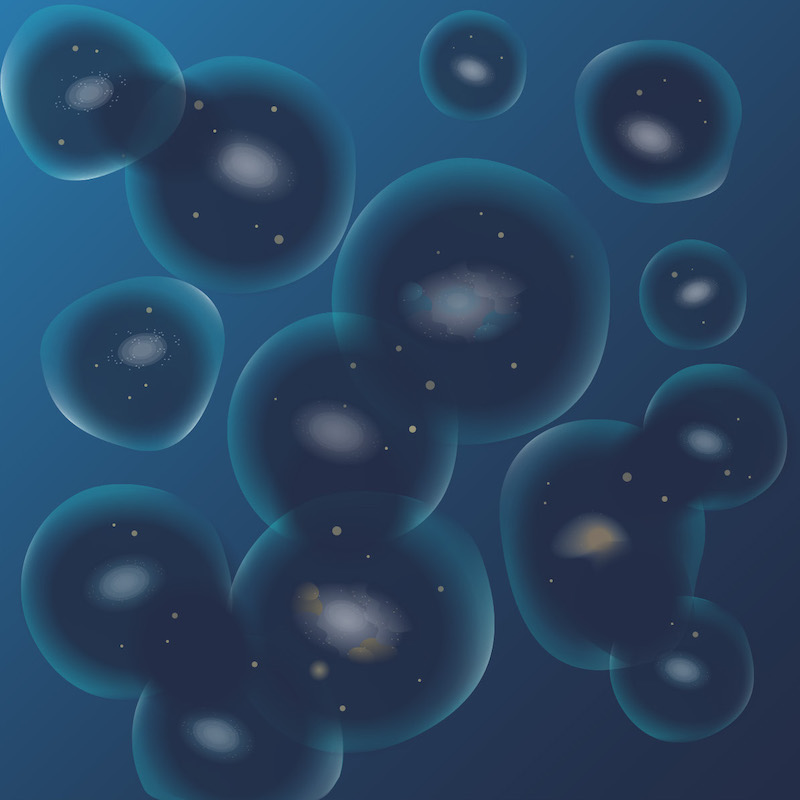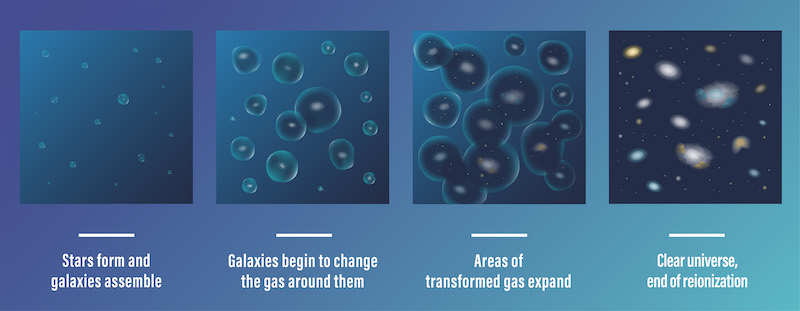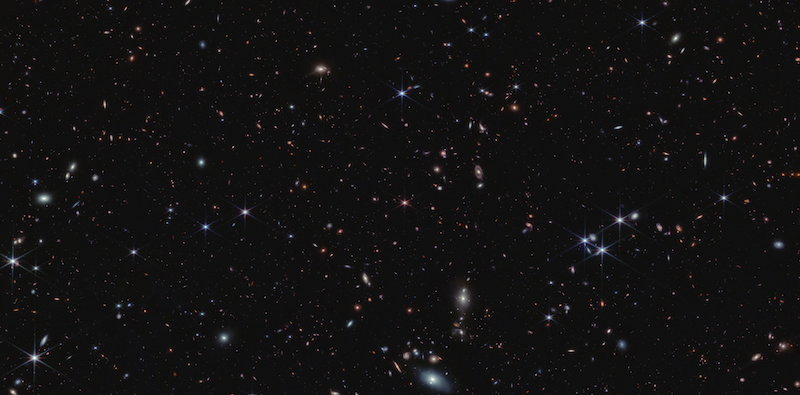
The universe we see today looks clear and empty, apart from the stars and galaxies. In the early universe, however, a few hundred million years after the Big Bang, the cosmos was opaque. Light from the stars couldn’t penetrate the dense hydrogen intergalactic gas. So, how did the universe become clear? Using data from NASA’s Webb Space Telescope, an international group of astronomers said on June 12, 2023, that light from stars ionized and heated the surrounding gas. This created huge transparent “bubbles” that eventually merged together, clearing the universe of the opaque gas. About one billion years after the Big Bang, the universe was completely transparent.
Simon Lilly of ETH Zürich in Switzerland led the international team of researchers. They published their peer-reviewed findings in three new papers (here, here and here) in The Astrophysical Journal on June 12, 2023.
Early universe was dense and opaque
After the Big Bang, intergalactic gas in the universe was dense and opaque. Starlight couldn’t penetrate the the cosmic fog. Gradually, over hundreds of millions of years, the gas cooled. But then, when stars and galaxies began to form, they heated up the gas again. As a result, the gas became ionized and started to thin out. By the time the universe was about a billion years old, it had become completely transparent.
This has been the accepted scenario among astronomers, but they still wanted more definitive evidence. The new results from Webb provide that.
Webb finds transparent ‘bubbles’ around galaxies
The new data from Webb finally provides the evidence for this clearing process. It shows that there were huge transparent regions, or “bubbles,” around galaxies at the end of the Epoch of Reionization. Lead author of the first paper, Daichi Kashino of Nagoya University in Japan, stated:
Not only does Webb clearly show that these transparent regions are found around galaxies, we’ve also measured how large they are. With Webb’s data, we are seeing galaxies reionize the gas around them.
At about 2 million light-years in radius, the transparent regions were much larger than the galaxies themselves. As an illustration, the astronomers compare a galaxy to a pea suspended inside a hot air balloon. To put it another way, the size of each bubble was approximately the same distance as the space between our Milky Way galaxy and our nearest neighbor, the Andromeda galaxy. These transparent bubbles continued to grow over the next hundred million years or so. Eventually, they merged together. As a result, the entire universe became transparent.
The Epoch of Reionization
Webb specifically looked at galaxies that were in existence just before the end of the Epoch of Reionization, over 13 billion years ago. (As with other telescopes, the farther away an object is when Webb looks at it, the farther back in time we are seeing it). At this time, the universe wasn’t as opaque as it was earlier, but it wasn’t transparent yet, either. Rather, it more like a mix of gas in different states.
The researchers expected to find a few dozen galaxies but discovered quite a few more. As Kashino explained:
We expected to identify a few dozen galaxies that existed during the Era of Reionization but were easily able to pick out 117. Webb has exceeded our expectations.

Using a quasar as a cosmic flashlight
To better understand the conditions of the universe at the time, the researchers used a natural cosmic flashlight, a quasar called J0100+2802. Quasars are extremely luminous, and their light passes through various gases in the universe as it moves toward us. The researchers measured how it traveled through different patches of gas and whether it was absorbed or passed right through. That provides clues as to how dense a particular patch of gas is.
It was painstaking work, and Webb’s results were then combined with ones from the W. M. Keck Observatory in Hawaii, the Very Large Telescope, and the Magellan Telescopes in Chile. As Anna-Christina Eilers of Massachusetts Institute of Technology (MIT) in Cambridge, Massachusetts, lead author of another paper, said:
By illuminating gas along our line of sight, the quasar gives us extensive information about the composition and state of the gas.

Webb finds a chaotic early universe
It was galaxies – and their transparent bubbles – near this line of sight that Webb focused on. These young galaxies were very active, chaotic even. Jorryt Matthee of ETH Zürich and lead author of that team’s second paper, said:
They are more chaotic than those in the nearby universe. Webb shows they were actively forming stars and must have been shooting off many supernovae. They had quite an adventurous youth!
The quasar contains a huge black hole, and Webb found that it is the most massive known in the early universe. Incredibly, it weighs in at approximately 10 billion times the mass of the sun.
Eilers added:
We still can’t explain how quasars were able to grow so large so early in the history of the universe. That’s another puzzle to solve!
The researchers will now continue to study other galaxies that also have central quasars.
Bottom line: NASA’s Webb Space Telescope has answered the question of how galaxies caused the early universe to transform from dense and opaque to clear and transparent.
Source: EIGER. III. JWST/NIRCam Observations of the Ultra-luminous High-redshift Quasar J0100+2802











